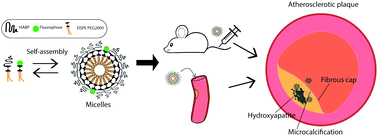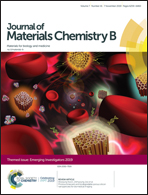Hydroxyapatite-binding micelles for the detection of vascular calcification in atherosclerosis†
Abstract
Atherosclerosis is a chronic disease characterized by the formation of calcified, arterial plaques. Microcalcifications (5 μm to 100 μm), mainly composed of hydroxyapatite (HA, Ca5(PO4)3(OH)), develop in the fibrous caps of atherosclerotic plaques and can trigger plaque rupture due to the loss of compliance and elasticity. Ultimately, plaque rupture can cause arterial occlusion and embolization and result in ischemic events such as strokes and myocardial infarctions. Unfortunately, current imaging technologies used to detect calcifications are limited by low signal-to-noise ratio or use invasive procedures that pose risk of arterial dissection. To mitigate these drawbacks, in our study, we developed a novel, fluorescently-labeled peptide amphiphile micelle (PAM) that uses a 12 amino acid HA-binding peptide (HABP) [SVSVGMKPSPRP] to target and detect atherosclerotic calcification (HA PAM). Our results show HA PAMs can successfully target HA microcrystals with a strong binding affinity (KD = 6.26 ± 1.2 μM) in vitro. In addition, HA PAMs detected HA mineralization (HA PAM vs. non-targeting micelle, p ≤ 0.001; HA PAM vs. scrambled HABP PAM, p ≤ 0.01) formed by calcifying mouse aortic vascular smooth muscle cells (MOVAS). Moreover, HA PAMs successfully detected calcifications in atherosclerotic mouse models as well as in patient-derived arteries. Our studies show that HA PAMs show promise as calcium-targeting nanoparticles for the detection of calcifications in atherosclerosis.

- This article is part of the themed collection: Journal of Materials Chemistry B Emerging Investigators


 Please wait while we load your content...
Please wait while we load your content...